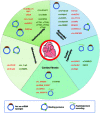Circular RNAs in Cardiovascular Diseases: Regulation and Therapeutic Applications
- PMID: 37040523
- PMCID: PMC10076034
- DOI: 10.34133/research.0038
Circular RNAs in Cardiovascular Diseases: Regulation and Therapeutic Applications
Abstract
Cardiovascular disease is one of the leading causes of mortality worldwide. Recent studies have shown that circular RNAs (circRNAs) have emerged as important players in the prevention and treatment of cardiovascular diseases. circRNAs are a class of endogenous noncoding RNAs that are generated by back-splicing and are involved in many pathophysiological processes. In this review, we outline the current research progress on the regulatory roles of circRNAs in cardiovascular diseases. Further, new technologies and methods available for identifying, validating, synthesizing, and analyzing circRNAs, as well as their applications in therapeutics, are highlighted here. Moreover, we summarize the increasing insights into the potential use of circRNAs as circulating diagnostic and prognostic biomarkers. Finally, we discuss the prospects and challenges of circRNA therapeutic applications for cardiovascular disease therapy, with a particular focus on developing circRNA synthesis and engineering delivery systems.
Copyright © 2023 Lijun Wang et al.
Figures






Similar articles
-
Expanding roles of circRNAs in cardiovascular diseases.Noncoding RNA Res. 2024 Feb 5;9(2):429-436. doi: 10.1016/j.ncrna.2024.02.001. eCollection 2024 Jun. Noncoding RNA Res. 2024. PMID: 38511061 Free PMC article. Review.
-
Circular noncoding RNAs as potential therapies and circulating biomarkers for cardiovascular diseases.Acta Pharmacol Sin. 2018 Jul;39(7):1100-1109. doi: 10.1038/aps.2017.196. Epub 2018 Mar 22. Acta Pharmacol Sin. 2018. PMID: 29565037 Free PMC article. Review.
-
Circular RNAs are a novel type of non-coding RNAs in ROS regulation, cardiovascular metabolic inflammations and cancers.Pharmacol Ther. 2021 Apr;220:107715. doi: 10.1016/j.pharmthera.2020.107715. Epub 2020 Oct 24. Pharmacol Ther. 2021. PMID: 33141028 Free PMC article. Review.
-
Circular RNAs and Hepatocellular Carcinoma: New Epigenetic Players With Diagnostic and Prognostic Roles.Front Oncol. 2021 Apr 20;11:653717. doi: 10.3389/fonc.2021.653717. eCollection 2021. Front Oncol. 2021. PMID: 33959506 Free PMC article. Review.
-
A narrative review of circular RNAs as potential biomarkers and therapeutic targets for cardiovascular diseases.Ann Transl Med. 2021 Apr;9(7):578. doi: 10.21037/atm-20-7929. Ann Transl Med. 2021. PMID: 33987276 Free PMC article. Review.
Cited by
-
CircRNA-based AntimiR therapy: A novel approach to hypertension treatment.Noncoding RNA Res. 2025 May 5;13:94-108. doi: 10.1016/j.ncrna.2025.05.001. eCollection 2025 Aug. Noncoding RNA Res. 2025. PMID: 40487299 Free PMC article. Review.
-
Non-coding RNAs in disease: from mechanisms to therapeutics.Nat Rev Genet. 2024 Mar;25(3):211-232. doi: 10.1038/s41576-023-00662-1. Epub 2023 Nov 15. Nat Rev Genet. 2024. PMID: 37968332 Review.
-
Unlocking the Therapeutic Applicability of LNP-mRNA: Chemistry, Formulation, and Clinical Strategies.Research (Wash D C). 2024 Jun 18;7:0370. doi: 10.34133/research.0370. eCollection 2024. Research (Wash D C). 2024. PMID: 38894715 Free PMC article. Review.
-
Circular RNA IGF1R Promotes Cardiac Repair via Activating β-Catenin Signaling by Interacting with DDX5 in Mice after Ischemic Insults.Research (Wash D C). 2024 Aug 27;7:0451. doi: 10.34133/research.0451. eCollection 2024. Research (Wash D C). 2024. PMID: 39193132 Free PMC article.
-
EIF4A3-Induced Circular RNA CircDdb1 Promotes Muscle Atrophy through Encoding a Novel Protein CircDdb1-867aa.Adv Sci (Weinh). 2024 Dec;11(45):e2406986. doi: 10.1002/advs.202406986. Epub 2024 Oct 16. Adv Sci (Weinh). 2024. PMID: 39412095 Free PMC article.
References
-
- Capel B, Swain A, Nicolis S, Hacker A, Walter M, Koopman P, Goodfellow P, Lovell-Badge R. Circular transcripts of the testis-determining gene Sry in adult mouse testis. Cell. 1993;73(5):1019–1030. - PubMed
-
- Memczak S, Jens M, Elefsinioti A, Torti F, Krueger J, Rybak A, Maier L, Mackowiak SD, Gregersen LH, Munschauer M, et al. . Circular RNAs are a large class of animal RNAs with regulatory potency. Nature. 2013;495(7441):333–338. - PubMed
-
- Chen LL. The biogenesis and emerging roles of circular RNAs. Nat Rev Mol Cell Biol. 2016;17(4):205–211. - PubMed
-
- Devaux Y, Creemers EE, Boon RA, Werfel S, Thum T, Engelhardt S, Dimmeler S, Squire I, on behalf of the Cardiolinc network . Circular RNAs in heart failure. Eur J Heart Fail. 2017;19(6):701–709. - PubMed
Publication types
LinkOut - more resources
Full Text Sources

